As someone with several pets, I know how irritating finding their fur everywhere can be! If you’re looking for a non-shedding dog breed, look no further than this article. Here are 13 for you to consider:
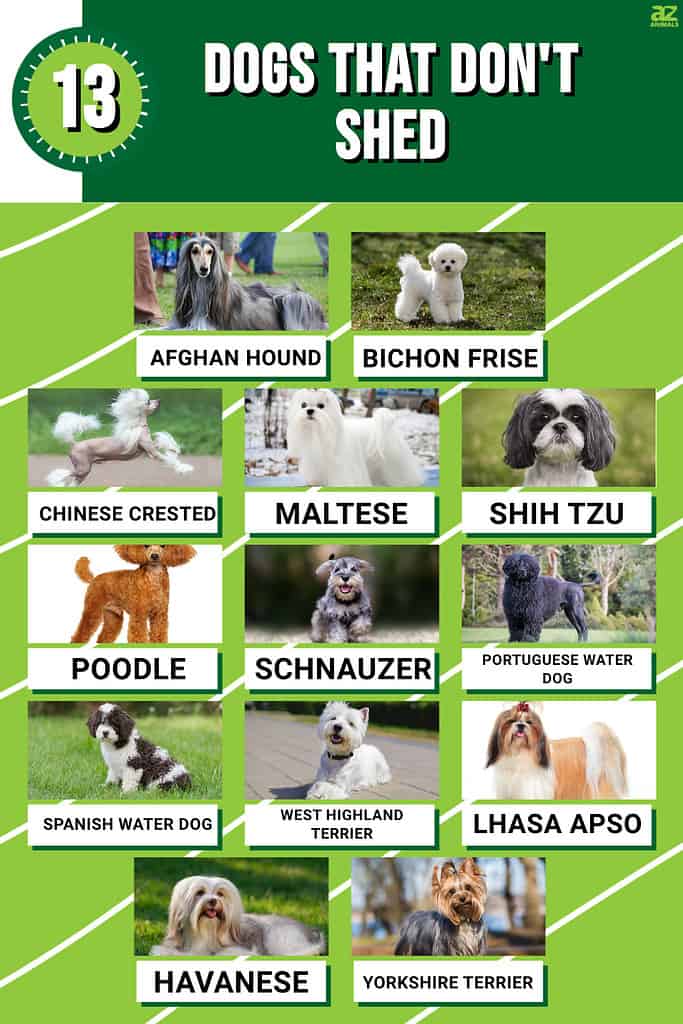
Non-shedding dogs require less fur clean-up, but they aren’t completely low-maintenance. Most will need to see a groomer regularly for a haircut, they can still trigger dog allergies, and many breeds on this list are clingy and can’t be left alone for long periods.
It’s important to remember that every dog will require a big commitment and to take this seriously when adopting. In this article, we’ll talk about thirteen dog breeds that don’t shed.
Facts About Non-Shedding Dogs
They Might Trigger Your Dog Allergies
Dog allergies aren’t triggered by fur, so these dogs not shedding might do very little to ease your symptoms if you are allergic to dogs.
Dander in the skin and the saliva is what causes allergies in people, and of course, all dogs have skin, groom themselves — and maybe give kisses! — regularly.
Instead of searching for a “hypoallergenic” breed, I recommend meeting with various dogs and spending a good amount of time with them. This can tell you how you’ll personally react to their dander.
Be sure to give them lots of pets, rubbing your hands down to the skin to release that dander. Touch your hands to your face, especially around your eyes and nose, to test for allergy symptoms before bringing the dog home. This will save you and your new dog heartache if you end up having an allergic reaction.
They Still Can be High-Maintenance
Some people want to adopt dogs that don’t shed, thinking they won’t need to spend as much time caring for their dog. Remember that all dogs require maintenance, even if their coat is easy to maintain.
In the case of these dogs, their fur doesn’t shed because it grows constantly. Therefore, it needs to be combed daily and trimmed once a month.
Many dogs on this list also need a lot of daily exercise, are clingy and prone to separation anxiety, or otherwise are high-maintenance in other areas! So, be sure to research thoroughly before adopting a new dog. Every breed takes time and effort.
Mixed Breeds are Likely to Shed
Unfortunately, there’s a lot of dishonest marketing going on in the breeding world. Unethical breeders will try to convince buyers that mixed breeds don’t shed, despite one parent belonging to a double-coated, shedding breed. This is a common lie told about Poodle mixes or “Doodles,” but also applies to other “designer dog” mixed breeds.
Please remember that when you mix two breeds with very different genetics, the outcome when it comes to health, coat, personality, and more is going to be randomized. Unless both parent breeds have a non-shedding coat, you may get a puppy who sheds heavily. You’re also very likely to end up with a coat that’s harder to maintain than that of either parent breed, due to it being a mix of two coat types.
The best solution is not to buy mixed-breed dogs, as they’re almost always unethically bred. If you’d like a wonderful mutt, there are millions in shelters and at rescues right now waiting for homes!
1. Afghan Hound
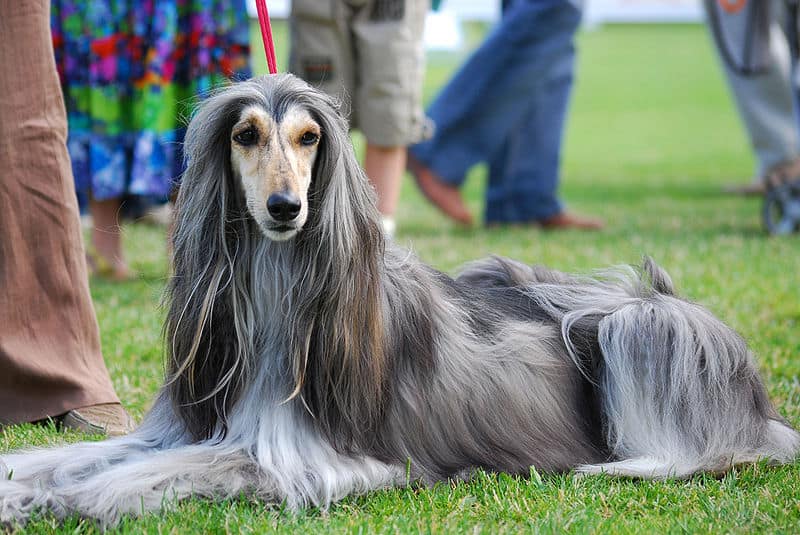
Afghan Hounds are non-shedding but have long, silky coats that require several hours of brushing every week.
©I, Lilly M, CC BY-SA 3.0, via Wikimedia Commons – License
Getting into the good stuff, the Afghan Hound is the first non-shedding breed on our list. These large dogs stand 25-27 inches tall and weigh 50-60 pounds. They have a long, silky coat that requires several hours of brushing every week and regular baths.
Afghan Hounds are quite high-energy and can be aloof, making them more difficult to train than other, eager-to-please breeds. Using patience and force-free training methods, though, you’ll find success! Be sure to offer high-value training treats to keep their focus.
2. Bichon Frise
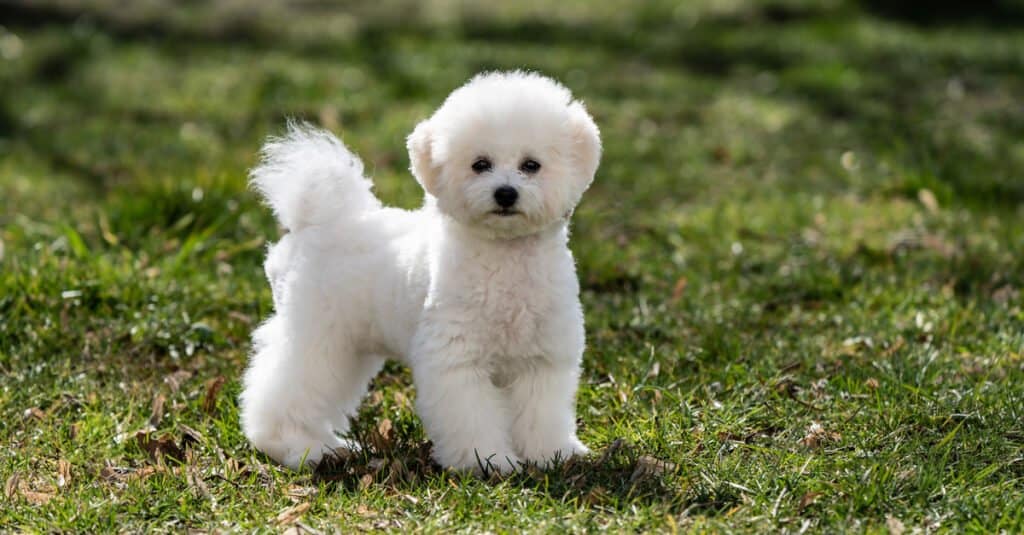
This soft dog breed, the Bichon Frise, is a great choice for someone with allergies.
©Ieva Tvaronavicute/Shutterstock.com
Bichon Frise dogs are tiny, weighing just 12-18 pounds and standing 9.5-11.5 inches at the shoulder.
These light-colored dogs are usually white, but can also have markings in various shades of tan. Their long, curly coats require daily brushing and a trim and bath once monthly, either from the groomer or at home.
As lap dogs, they’re known for being incredibly affectionate, even toward kids and other dogs. Of course, always introduce new pets slowly and with supervision, and never leave kids and dogs unsupervised together!
Bichon Frises are also playful, high-energy, and pretty easy to train. Because they can be clingy, they’re best suited to a household where at least one person is home most of the day.
3. Chinese Crested

The Chinese crested dog is a small toy breed that has smooth, hairless skin with a flowing mane and big, fluffy ears.
©Abramova Kseniya/Shutterstock.com
I think you either love or hate Chinese Crested dogs. Me? I think they’re adorable! (But then again, I’ve never met a dog who wasn’t in my eyes!)
If you’ve never seen a dog with bangs, I suggest you run—not walk!—to the American Kennel Club page for this breed! These pups can either be mostly hairless with long fur on the face, legs, and tail or have a long coat almost everywhere.
The hairless version must have their exposed skin cared for, including applying sunscreen before letting them outside! Brush the fur daily where it grows out and trim it as needed. The “haired” Chinese Cresteds, also known as Powderpuff, must be brushed daily as they tangle and mat easily.
Chinese Crested dogs have moderate energy levels and will need daily activity to stay healthy. Since they’re small (just 8-12 pounds and 11-13 inches), you might be able to get away with playtime indoors during bad weather.
4. Maltese
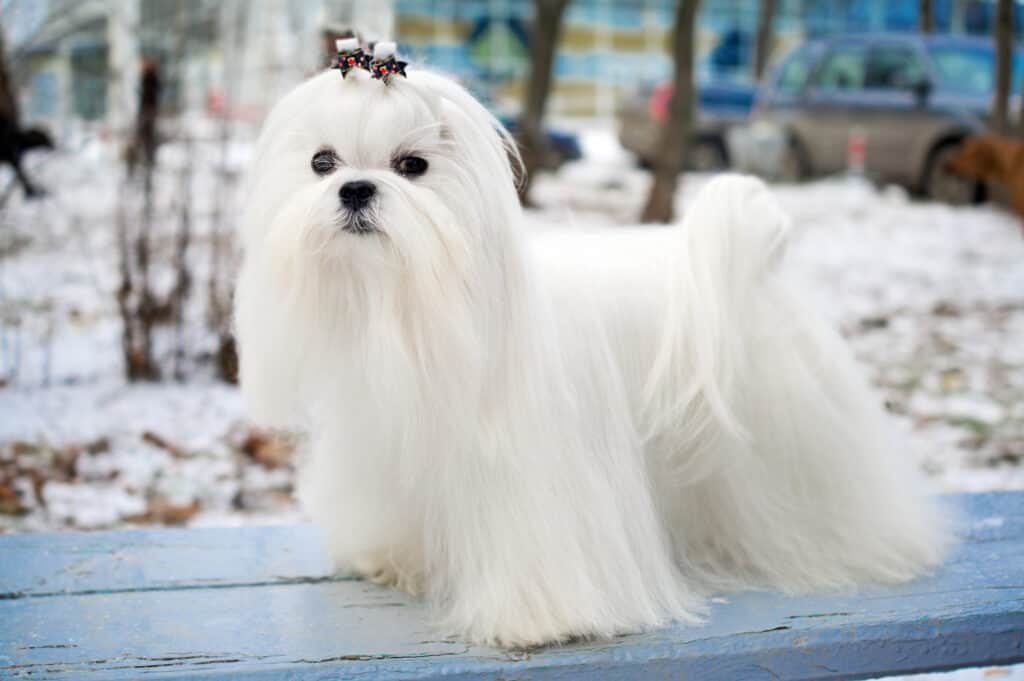
Maltese dogs are non-shedding but should be brushed daily, and trimmed and bathed regularly.
©iStock.com/Laures
Maltese dogs are just 7-9 inches tall and weigh under 9 pounds. Their long fur is always white, sometimes with black points. They should be brushed daily, and trimmed and bathed regularly. The AKC also recommends conditioning the coat during bath time to keep it healthy and soft.
Another lap dog breed, Maltese dogs shouldn’t be left alone for long periods. If someone is home most of the day, your family might be right for one of these pups!
Maltese dogs have moderate energy levels and also moderate trainability, sitting somewhere between eager-to-please and completely aloof breeds.
Because these dogs can be brachycephalic, or short-snouted, I recommend being extra careful in your search for a reputable breeder. Be sure they put the dog’s health first, including breeding for a good snout length and health testing the parent dogs for genetic conditions.
5. Shih Tzu

Shih Tzus were originally bred by Chinese royalty! They have long coats and come in a variety of colors.
©Angel LeBlanc/Shutterstock.com
Shih Tzus are 9-10.5 inches tall and weigh 9-16 pounds. Their beautiful, long coat comes in a wide variety of colors, but also requires a lot of maintenance. They should be brushed daily and bathed regularly by either yourself or a groomer. Most people opt to trim their Shih Tzu’s fur once a month to keep it easier to manage.
Shih Tzus tend to be great with other dogs and children, though you should always supervise interactions between dogs and kids! Both can hurt one another, even when they aren’t trying, such as during rough play.
Like the other lap dog breeds on this list, Shih Tzus are clingy, affectionate, and prone to separation anxiety. They can only be left for short periods throughout the day, and aren’t for a single person who works full-time outside of the house!
If you want a Shih Tzu, I recommend avoiding breeders at all costs. This is because these dogs aren’t responsibly bred. Their short snouts make it difficult even to breathe, alongside a host of other health problems. The best way to find a Shih Tzu to adopt is to call your local shelters or find a Shih Tzu-specific rescue in your area.
6. Poodle

Miniature poodles are hypoallergenic dogs.
©Jagodka/Shutterstock.com
Poodles are bred in three sizes: toy, miniature, and standard. Toys are under 10 inches and weigh 4-6 pounds. The minis are 10-15 inches tall and weigh 10-15 pounds, while Standard Poodles are over 15 inches tall and weigh 40-70 pounds.
All have long, curly coats and are born in a variety of colors. Their coats need daily maintenance and regular trims and baths. Most people opt to visit the groomer once a month to keep their Poodle’s coat maintained, as it’s difficult to do so by yourself at home.
Poodles are affectionate, protective, and playful. They’re very high-energy and require a lot of daily exercise. Because they’re incredibly intelligent, they also require a lot of mental stimulation. They can be clingy and shouldn’t be left alone for long periods.
7. Schnauzer
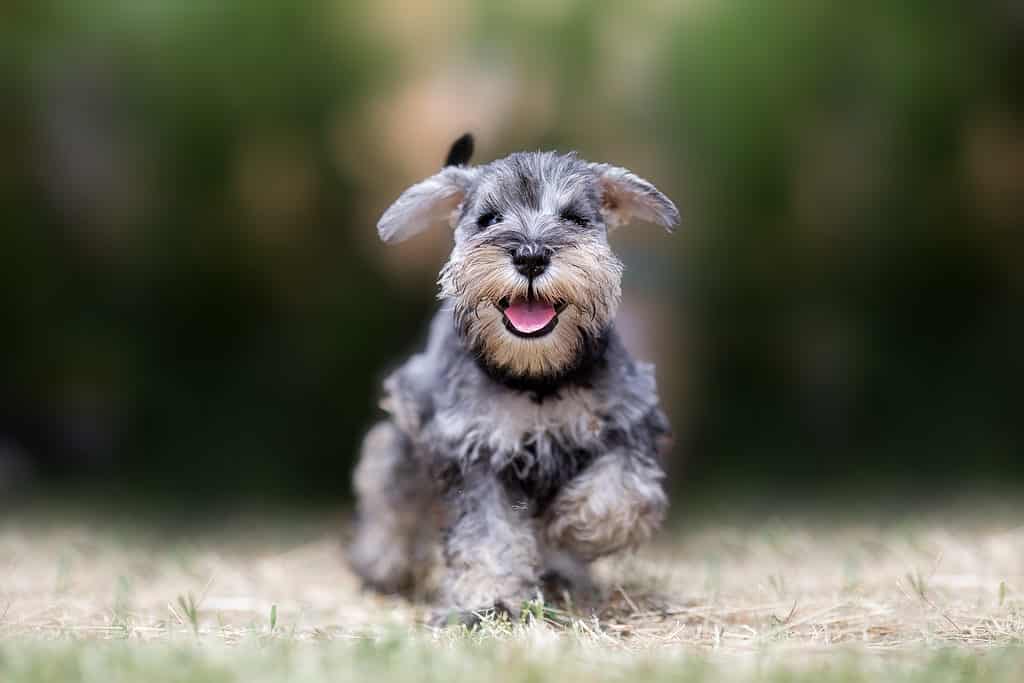
Some Schnauzers have their fur clipped short, but they will shed more this way. With hand-stripping, they shed very minimally.
©Lunja/Shutterstock.com
Like Poodles, Schnauzers have also bred three variations. Standard Schnauzers are 17.5-19.5 inches tall and weigh 30-50 pounds, while Miniature Schnauzers are 12-14 inches and weigh 11-20 pounds. Giant Schnauzers are 23.5-27.5 inches tall and weigh 55-85 pounds.
Schnauzers have unique coats that are wiry in texture. They require daily brushing and regular hand-stripping, which is the process of pulling out the dead undercoat by hand. Some Schnauzers have their fur clipped short instead, but they will shed more this way. With hand-stripping, Schnauzers shed very minimally.
Alongside this, these dogs should be bathed around once a month and have their beard and legs washed weekly to keep them clean.
Schnauzers also tend to drool more than the other dogs on this list. While it isn’t excessive, it might be worth avoiding this breed if you have dog allergies triggered by their saliva.
Both Schnauzer sizes are affectionate, playful, protective, and eager to please. Despite their playfulness, they only have moderate energy levels, so you won’t have to go on long hikes to wear them out, but they still need daily activity to stay healthy.
8. Portuguese Water Dog
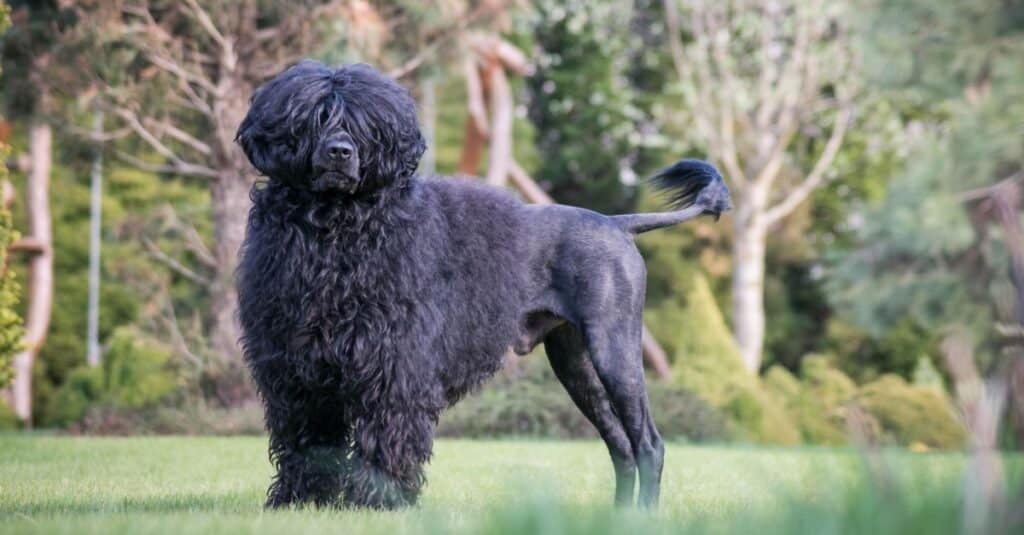
Portuguese Water Dogs have long, wavy coats and can dive as deep as 12 feet while chasing fish!
©Eve Photography/Shutterstock.com
Portuguese Water dogs are large dogs, standing 17-23 inches tall and weighing 35-60 pounds. Their long, wavy coats require daily brushing unless they’re trimmed short, in which case they’ll need regular trips to the groomer for a trim and bath.
They’re incredibly social, eager to please, and high energy. They also need a lot of mental stimulation to keep them happy and out of trouble!
Due to their high energy and potential for clinginess, it’s not recommended to adopt a Portuguese Water dog unless someone can be home with them most of the day.
9. Spanish Water Dog
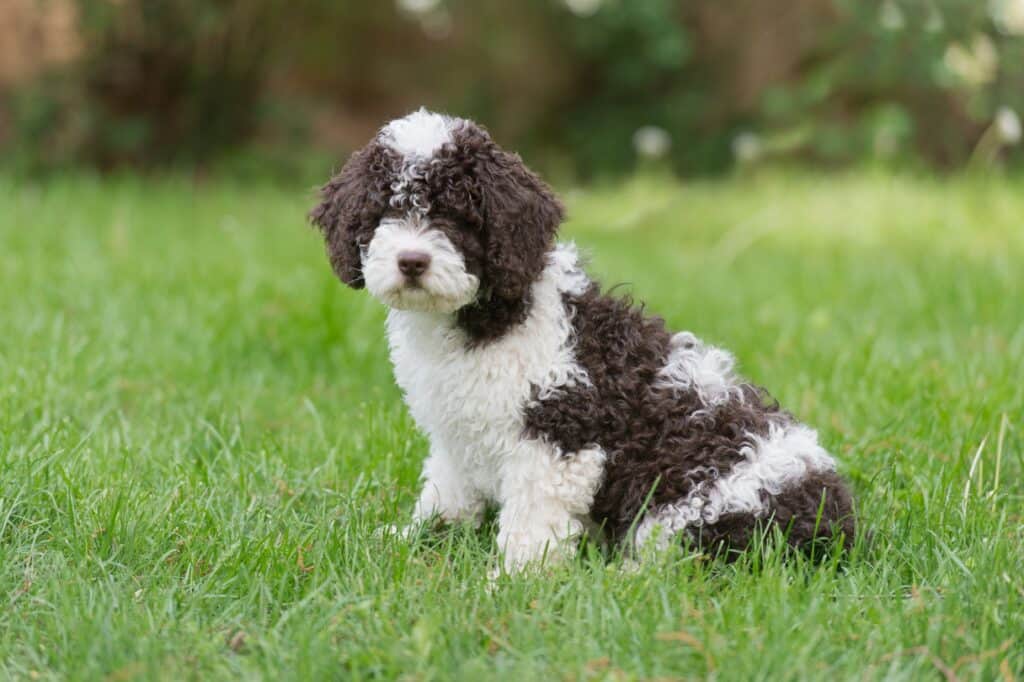
Spanish water dogs are medium-sized with adorable, long, corded coats.
©Copper Kennel/Shutterstock.com
Spanish Water dogs have curly, corded coats and stand 15.75-19.75 inches tall. They weigh between 31-49 pounds.
Their coats should never be brushed, but instead either clipped short or grown out and corded. It’s important to be experienced in cording Spanish Water dog coats so that it’s done right and the fur is kept healthy.
These pups are affectionate, playful, and eager to please. They’re also high energy with an even higher need for mental stimulation.
10. West Highland White Terrier

The West Highland Terrier is also known as a Westie.
©iStock.com/Eudyptula
West Highland White Terriers, or Westies, are 10-11 inches tall and weigh 15-20 pounds. As their name implies, these dogs have long, white fur.
Their coat should be brushed daily and either clipped or hand-stripped. The AKC advises against too many baths, but your dog will likely still need one now and then!
Westies are affectionate and protective of their families, playful, and high-energy. They aren’t super eager to please, but also not as difficult to train as other, more aloof breeds. Be sure to keep sessions short and interesting so they stay engaged!
11. Lhasa Apso
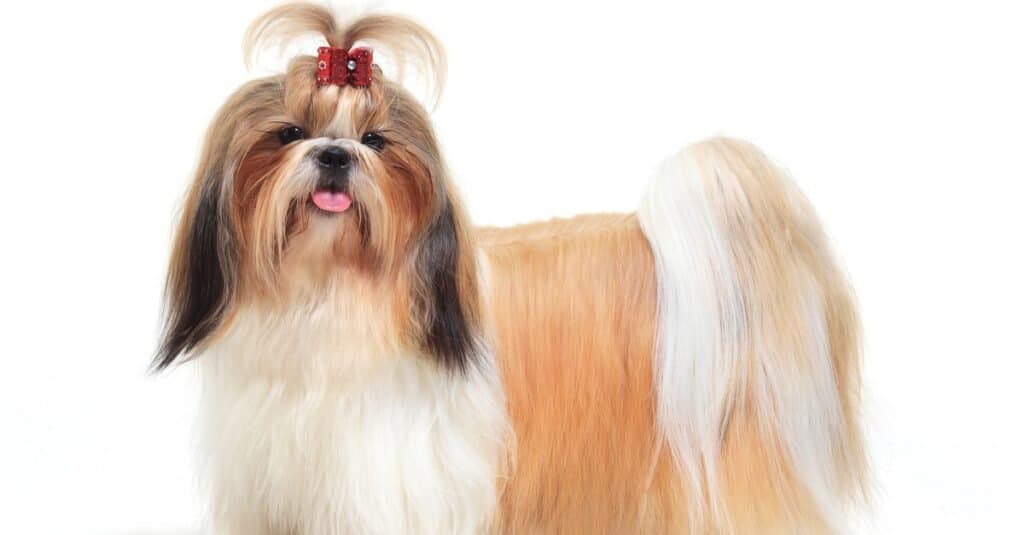
Lhasa Apsos have long, silky hair that must be brushed daily or clipped short every 4-6 weeks.
©Rombrant77/Shutterstock.com
Lhasa Apsos are tiny dogs, weighing 12-18 pounds. Males are 10-11 inches tall, and females are “slightly smaller” according to the AKC. These pups have long, silky hair that must be brushed daily or clipped short every 4-6 weeks. They should be bathed regularly.
Lhasa Apsos are affectionate and can be quite clingy and prone to separation anxiety. They shouldn’t be left alone for long periods. They also have moderate energy and trainability levels, so it might take some extra effort to keep them engaged in learning new things!
Because they’re poorly bred with short muzzles and breathing difficulties, amongst other health concerns, I don’t recommend buying a Lhasa Apso from a breeder. Please look into your local rescue organizations instead!
12. Havanese

Havanese dogs have long, non-shedding fur. They need to be brushed daily and trimmed and bathed every four to six weeks.
©Dorottya Mathe/Shutterstock.com
At 7-13 pounds and 8.5-11.5 inches, Havanese dogs have long, non-shedding fur. They need to be brushed daily and trimmed and bathed every four to six weeks.
These beautiful pups are adaptable, friendly, and playful. They can be clingy and shouldn’t be left alone for long periods. Havanese dogs need moderate exercise and might be a bit of a challenge to train, but nothing that a positive attitude, patience, and high-value rewards won’t solve!
13. Yorkshire Terrier
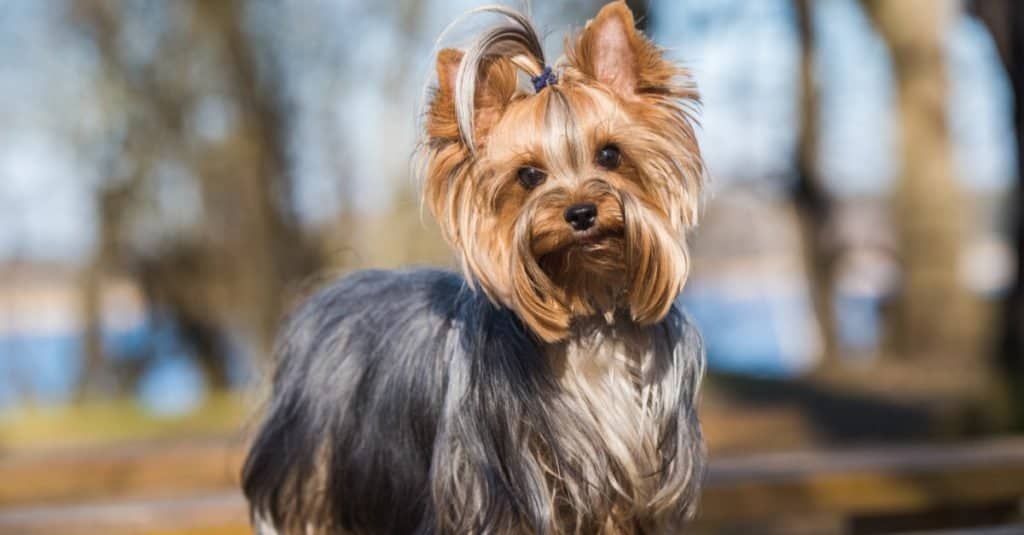
Yorkshire terriers, or Yorkies, have long silky fur and are playful.
©Zanna Pesnina/Shutterstock.com
Yorkshire Terriers, or Yorkies, are very small, standing just 7-8 inches tall and weighing 7 pounds. They have long, silky, bi-colored fur that requires daily brushing and a trim and bath every 4-6 weeks.
Yorkies are friendly, playful, and adaptive. They’re pretty eager to please, so training should be a breeze! While they need plenty of exercise, playtime in the living room can drain a lot of their energy.
As with some other dogs on our list, Yorkies are short-snouted which causes a variety of health problems. These dogs aren’t ethically bred, and buying them supports poor breeding. Therefore, I recommend adopting a Yorkie from a rescue or shelter instead.
Summary of the 13 Dogs That Don’t Shed
| Number | Dog |
|---|---|
| 1 | Afghan Hound |
| 2 | Bichon Frise |
| 3 | Chinese Crested |
| 4 | Maltese |
| 5 | Shih Tzu |
| 6 | Poodle |
| 7 | Schnauzer |
| 8 | Portuguese Water Dog |
| 9 | Spanish Water Dog |
| 10 | West Highland White Terrier |
| 11 | Lhasa Apso |
| 12 | Havanese |
| 13 | Yorkshire Terrier |
The photo featured at the top of this post is © Kristina Arba/Shutterstock.com
Ready to discover the top 10 cutest dog breeds in the entire world?
How about the fastest dogs, the largest dogs and those that are -- quite frankly -- just the kindest dogs on the planet? Each day, AZ Animals sends out lists just like this to our thousands of email subscribers. And the best part? It's FREE. Join today by entering your email below.
Thank you for reading! Have some feedback for us? Contact the AZ Animals editorial team.






